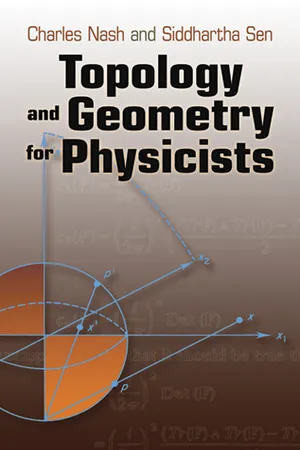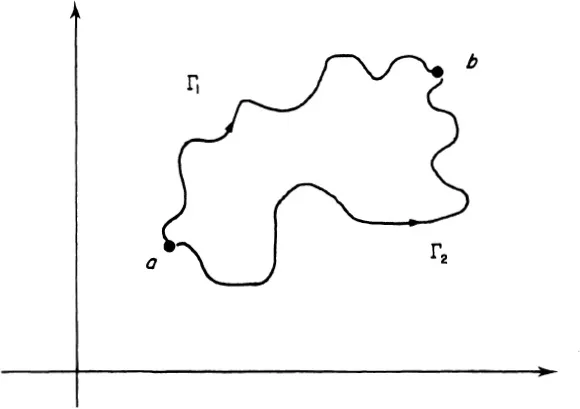
- 320 pages
- English
- ePUB (mobile friendly)
- Available on iOS & Android
eBook - ePub
Topology and Geometry for Physicists
About this book
Differential geometry and topology are essential tools for many theoretical physicists, particularly in the study of condensed matter physics, gravity, and particle physics. Written by physicists for physics students, this text introduces geometrical and topological methods in theoretical physics and applied mathematics. It assumes no detailed background in topology or geometry, and it emphasizes physical motivations, enabling students to apply the techniques to their physics formulas and research.
"Thoroughly recommended" by The Physics Bulletin, this volume's physics applications range from condensed matter physics and statistical mechanics to elementary particle theory. Its main mathematical topics include differential forms, homotopy, homology, cohomology, fiber bundles, connection and covariant derivatives, and Morse theory.
"Thoroughly recommended" by The Physics Bulletin, this volume's physics applications range from condensed matter physics and statistical mechanics to elementary particle theory. Its main mathematical topics include differential forms, homotopy, homology, cohomology, fiber bundles, connection and covariant derivatives, and Morse theory.
Frequently asked questions
Yes, you can cancel anytime from the Subscription tab in your account settings on the Perlego website. Your subscription will stay active until the end of your current billing period. Learn how to cancel your subscription.
No, books cannot be downloaded as external files, such as PDFs, for use outside of Perlego. However, you can download books within the Perlego app for offline reading on mobile or tablet. Learn more here.
Perlego offers two plans: Essential and Complete
- Essential is ideal for learners and professionals who enjoy exploring a wide range of subjects. Access the Essential Library with 800,000+ trusted titles and best-sellers across business, personal growth, and the humanities. Includes unlimited reading time and Standard Read Aloud voice.
- Complete: Perfect for advanced learners and researchers needing full, unrestricted access. Unlock 1.4M+ books across hundreds of subjects, including academic and specialized titles. The Complete Plan also includes advanced features like Premium Read Aloud and Research Assistant.
We are an online textbook subscription service, where you can get access to an entire online library for less than the price of a single book per month. With over 1 million books across 1000+ topics, we’ve got you covered! Learn more here.
Look out for the read-aloud symbol on your next book to see if you can listen to it. The read-aloud tool reads text aloud for you, highlighting the text as it is being read. You can pause it, speed it up and slow it down. Learn more here.
Yes! You can use the Perlego app on both iOS or Android devices to read anytime, anywhere — even offline. Perfect for commutes or when you’re on the go.
Please note we cannot support devices running on iOS 13 and Android 7 or earlier. Learn more about using the app.
Please note we cannot support devices running on iOS 13 and Android 7 or earlier. Learn more about using the app.
Yes, you can access Topology and Geometry for Physicists by Charles Nash,Siddhartha Sen, Siddhartha Sen in PDF and/or ePUB format, as well as other popular books in Mathematics & Topology. We have over one million books available in our catalogue for you to explore.
Information
CHAPTER 1
Basic Notions of Topology and the Value of Topological Reasoning
1.1 INTRODUCTION
Topology can be thought of as a kind of generalization of Euclidean geometry, and also as a natural framework for the study of continuity. Euclidean geometry is generalized by regarding triangles, circles, and squares as being the same basic object. Continuity enters because in saying this one has in mind a continuous deformation of a triangle into a square or a circle, or indeed any arbitrary shape. A disc with a hole in the centre is topologically different from a circle or a square because one cannot create or destroy holes by continuous deformations. Thus using topological methods one does not expect to be able to identify a geometrical figure as being a triangle or a square. However, one does expect to be able to detect the presence of gross features such as holes or the fact that the figure is made up of two disjoint pieces etc. This leads to the important point that topology produces theorems that are usually qualitative in nature—they may assert, for example, the existence or non-existence of an object. They will not in general, provide the means for its construction.
Let us begin by looking at some examples where topology plays a role.
Example 1. Cauchy’s residue theorem
Consider the contour integral for a meromorphic function f(z) along the path Γ1 which starts at a and finishes at b (c.f. Fig. 1.1). Let us write

Now deform the path Γ1 continuously into the path Γ2 shown in Fig. 1.1. Provided we cross no poles of f(z) in deforming Γ1 into Γ2, then Cauchy’s theorem for meromorphic functions allows us straightaway to deduce that

Figure 1.1

This is just the statement that

where C is the closed contour made up by joining Γ1 to Γ2 and reversing the arrow on Γ1 so as to give an anticlockwise direction to the contour C. The intuitive content of this result is that to integrate f(z) from a to b in the complex plane is independent of the path joining a to b (under the conditions stated). Even if we relax these conditions and allow that the deformation of Γ1 into Γ2 may entail the crossing of some poles of f(z), then we still have complete knowledge of the relationship of the two integrals. It is simply

where the sum is over the residues, if any, of the poles inside C. This simple example uncovers some topological properties underlying the familiar Cauchy theorem.
Example 2. The fundamental theorem of algebra
In this example we shall use the Cauchy theorem to give a proof of the fundamental theorem of algebra. First of all a simple consequence of Cauchy’s theorem is that for a meromorphic function f(z) we have

where n0 and np are the number of zeroes and the number of poles respectively of f(z) lying inside C Let f(z) be the polynomial Q(z) of degree q where

Then since Q(z) has no poles we have

It is clear that n0 is a continuous function of q of the q + 1 coefficients a0, . . ., aq. Let us select the coefficients a0, . . ., aq − 1 and write

However, n0 also only takes integer values. Now since it is impossible to continuously jump from one integer value to another it follows that n0 must be invariant under continuous change of the ai’s. This state of affairs permits the following argument: for large |z|, say |z| > R, |Q(z)|, grows as |aq||z|q which is a large number. Then if C is a circ...
Table of contents
- Cover
- Title Page
- Dedication
- Contents
- Chapter 1. Basic Notions of Topology and the Value of Topological Reasoning
- Chapter 2. Differential Geometry: Manifolds and Differential Forms
- Chapter 3. The Fundamental Group
- Chapter 4. The Homology Groups
- Chapter 5. The Higher Homotopy Groups
- Chapter 6. Cohomology and De Rham Cohomology
- Chapter 7. Fibre Bundles and Further Differential Geometry
- Chapter 8. Morse Theory
- Chapter 9. Defects, Textures and Homotopy Theory
- Chapter 10. Yang-Mills Theories: Instantons and Monopoles
- Further Reading
- Subject Index